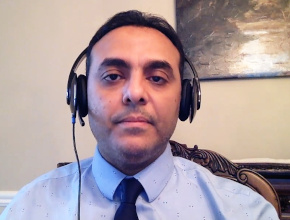Dr R. Phillip Dellinger, professor of medicine, senior critical care attending at Cooper University Health Care, past president of the Society of Critical Care Medicine, lead author of the Surviving Sepsis Campaign guidelines (2004, 2008, 2012), joins Dr Roman Jaeschke to discuss ICU management of COVID-19 patients based on a New Jersey example.
Roman Jaeschke, MD, MSc: Good morning. Welcome to another edition of McMaster Perspective COVID-19: To Treat or Not to Treat? series. We’re again joined by Dr Phil Dellinger, an expert in everything related to sepsis and critical care, who doesn’t need another introduction.
Dr Dellinger, the first question: We both have just spent another week in intensive care units (ICUs), looking, among others, after patients with coronavirus disease 2019 (COVID-19). What is the situation in your area [New Jersey]?
R. Phillip Dellinger, MD, MSc: Clearly the patients are a lot sicker and there’s a lot more of them. During my week I had 15 ICU beds, 13 mechanically ventilated COVID-19 patients, 4 on extracorporeal membrane oxygenation (ECMO), 3 on renal replacement therapy (RRT). So it’s a much sicker group.
We now have 4 COVID-19 ICU areas. Before I think we had our traditional 2 units, now all COVID-19, and we were opening up a third unit.
It does appear to have plateaued. I came off last weekend and it does appear to have plateaued this week. We clearly have decreased hospital admissions from COVID-19. The problem is that a lot of these patients of whom we hope a significant percentage will get better and we’ll be able to make them well and discharge stay on ventilatory support or even ECMO support for a long time. It’s just a very slow process moving them through the ICU.
Roman Jaeschke: Please tell us where you are, with 4 ICUs full of COVID-19 patients. Maybe everybody knows you, but now everyone knows where you work.
R. Phillip Dellinger: I’m in a Philadelphia area hospital in South Jersey. It’s Cooper University Health Care, Cooper Medical School of Rowan University. It’s a 680-bed coordinated care hospital.
It’s been very unique for me in that we have filled up our 30-bed medical/surgical unit with COVID-19 patients. Then we filled up our coronary care unit with COVID-19 patients. Now we’ve opened up a regular hospital ward, with individual patient rooms, that have COVID-19 patients, even those mechanically ventilated, in private hospital [regular] floor rooms, which, as you can imagine, creates challenges for monitoring.
Roman Jaeschke: I’m clearly in a better situation [in Hamilton], because we only had a handful of ventilated patients with COVID-19.
This was your consecutive week with COVID-19. Can you compare those weeks? Can you compare what you’re doing, your experience, clinical management? Anything that you’ve learned?
R. Phillip Dellinger: I think I’ve learned to appreciate the procoagulant state and recognize how it’s very likely to be important in the progression and complications of this disease. I have a much lower threshold for fully anticoagulating these patients, even prior to identifying macrothrombosis.
I’ve learned that low-molecular-weight heparin may be a better choice for full anticoagulation, because these patients appear to be somewhat resistant to unfractionated heparin, based on looking at the effect on factor Xa activity. I realized that in the RRT patients or patients with renal dysfunction of significance we’re forced to use unfractionated heparin.
I’ve recognized, based on personal observation with the D-dimer, macrothrombosis, behavior of this L phenotype [see COVID-19: To treat or not to treat? April 26 update]—with not a lot of air-space disease, vasoplegia, a lot of hypoxemia, fairly good compliance—that this is indeed, as people are recognizing throughout the world, primarily a vascular disease. This is a systemic vascular disease in which the showcase organ is the lungs—maybe because the lung gets all the blood flow, maybe because the virus enters through the airspaces. But it’s clearly a systemic vasculitis that’s triggering procoagulant activity and is producing a multiorgan dysfunction–type syndrome.
Roman Jaeschke: Somehow we are all migrating towards more intensity of prophylactic or, as you’re saying, full anticoagulation. As a minimum, I suspect you use prophylactic doses. Do you use some intermediate doses as well? Or do you wait for some confirmation?
R. Phillip Dellinger: We are more diligent about prophylaxis, as you’re aware. Some of the China data links prophylactic heparin with better outcomes. We’re not using intermediate doses. We go to full anticoagulation when the D-dimer crosses 3 mg/L (based on our units), or 3000 ng/mL (based on other units that I can’t remember).
Roman Jaeschke: So you measure if it’s high and effectively you fully anticoagulate. Interesting. Obviously it would be fascinating to see it tested somehow, but your clinical experience is pointing to procoagulant state.
Anything else you could share with us?
R. Phillip Dellinger: Compared with the last time, because my patients are so much sicker, there’s a group of the H-type patients—the traditional acute respiratory distress syndrome (ARDS) with the white lungs and very poor compliance—that are just stuck. They’re requiring very high oxygen concentrations, either with ECMO or with ventilators, and they have very low compliances, in the mid-teens range (mL per cm of water pressure). We’ve been proning them back and forth and back and forth, and they have problems with skin breakdown. These may be the younger people, where you don’t want to give up.
They’ve gotten hydroxychloroquine, which I don’t believe in anymore. They’ve gotten 2 doses of tocilizumab, the anti-interleukin (IL)-6 receptor antibody, and they’re just sitting there. You’re trying to figure out what to do with them when they’re out for 14 days. There’re 2 options: either you can let 90% oxygen be the new 40%, like orange is the new black, or you can give them steroids, treating them more like the LaSRS (Late Steroid Rescue Study) from the ARDS Network and using the Meduri protocol for patients, which seemed to have a continued dense fibroproliferative-type ARDS despite the fact that they’re far enough out and you would anticipate they would be getting better.
So some of those people are getting steroids and some are not. We’re not using steroids upfront—the great majority of our attendings are not—because we’re concerned about viral clearance.
Roman Jaeschke: Thank you very much for those comments. We started to talk about medication treatment, steroids. Has the pattern of treatment specific for COVID-19 changed over the last few weeks in your unit?
R. Phillip Dellinger: It really hasn’t. We do not have a set protocol per se, but we have an algorithm that’s created by our infectious disease department with input from critical care. It still has hydroxychloroquine on it, but we don’t have much faith in hydroxychloroquine anymore. The data is obviously mixed and there is potential toxicity. The last time we chatted the World Health Organization (WHO) SOLIDARITY study had prematurely put results of a clinical trial on the website that showed no benefit and then took it off. So we’re waiting on the peer review.
We’ve taken azithromycin off of the algorithm because of the increased problems with QT if you combine it with hydroxychloroquine. We still have lopinavir/ritonavir on the algorithm, but again, there’s no data that it makes a difference in outcome and it does interfere with some metabolism.
We anticipate getting remdesivir as an antiviral replacement, and I think we will use that.
We’re giving convalescent plasma to the patients that are severely ill. If you look at the chalkboard logic, you’d think that it would be best given to people early in the disease to help with viral clearance as opposed to later, with more severe illness. And that’s pretty much where we are.
Roman Jaeschke: How about IL-6?
R. Phillip Dellinger: We’re still giving the anti-IL-6, but again, with increasing concerns that we don’t know that it’s effective. We’re also concerned about secondary bacterial infections in these patients.
Roman Jaeschke: So it’s lots of uncertainty. It’s clearing faster than I’ve ever seen in the past but uncertainty persists and we’re all waiting for any major announcement and more definitive results by the sound of it.
R. Phillip Dellinger: Correct.
Roman Jaeschke: Any short-term predictions for the future? I’ll try to talk to you again in a few weeks. Do you think there will be something different to talk about at that time?
R. Phillip Dellinger: I think when we talk again, we’ll realize that hydroxychloroquine doesn’t work. I think we’ll know more about remdesivir, and I think it’ll be used in most patients. But it’s not a home run. If you look at what it does, it’s not a critical care drug. It’s not a life-and-death-changing type of drug. But any little bit helps, I guess.
Roman Jaeschke: Thank you for sticking out your neck for the predictions about the future, which is always difficult. Let’s hope next time we talk we’ll have something positive and happier to talk about. Thank you very much.
R. Phillip Dellinger: Thank you.
 English
English
 Español
Español
 українська
українська











